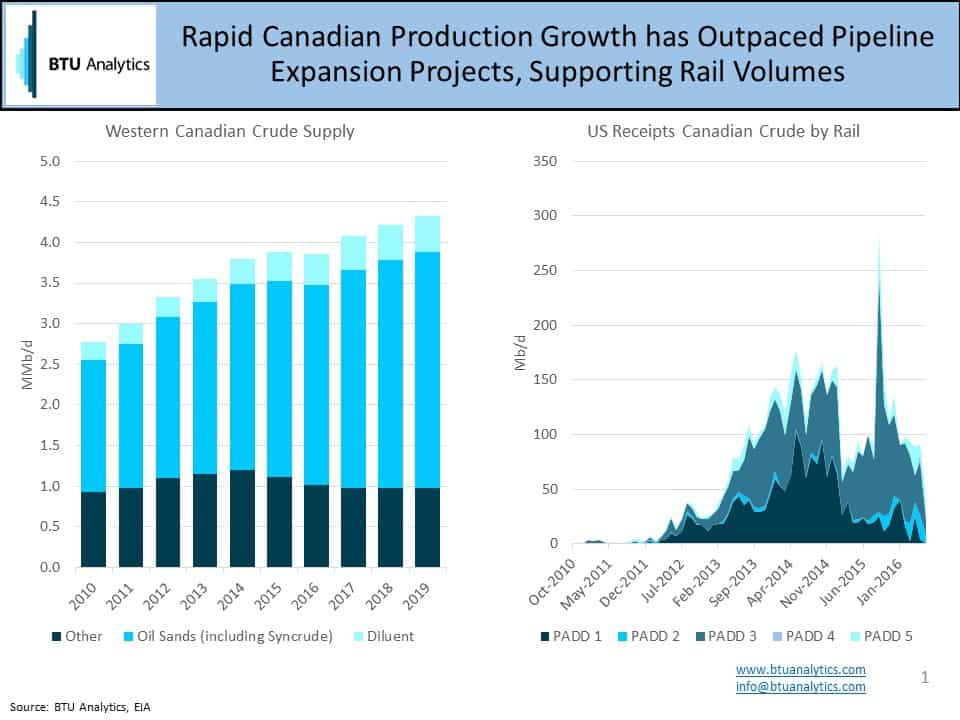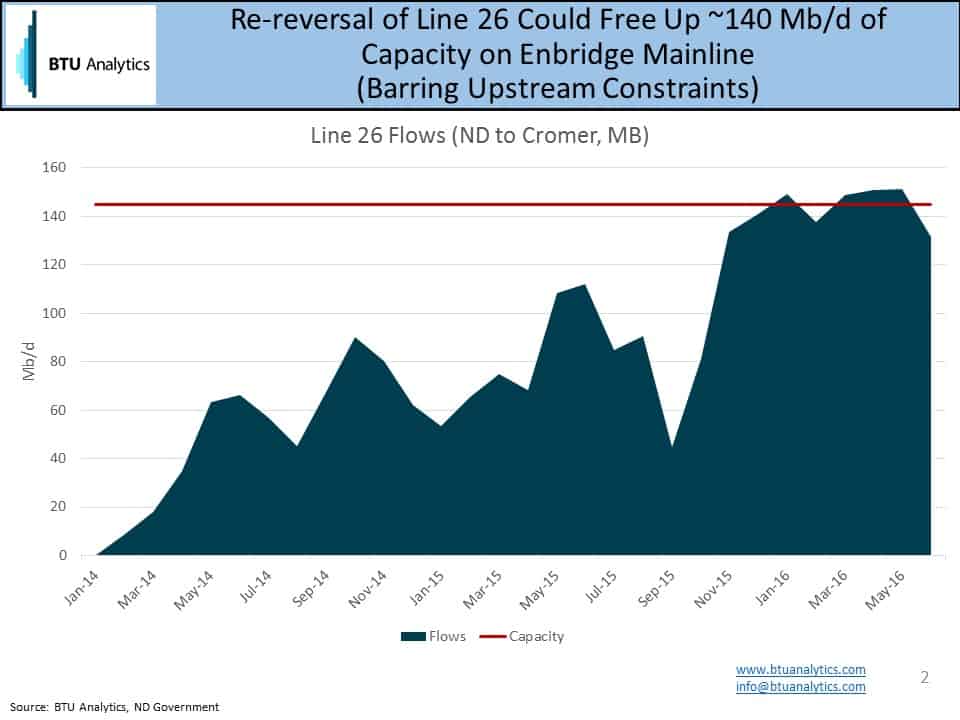On Tuesday during CNBC’s Power Lunch, Brian Sullivan proposed the idea that Dakota Access Pipeline (DAPL) could be a Keystone XL replacement. While Dakota Access in its current form is a pipeline project that will connect the Bakken to the Gulf Coast, let’s explore the merits and feasibility of this idea.
Canada continues to be one of the last bastions of crude by rail as pipelines to help debottleneck growing Canadian production continue to face pushback from environmental and community groups. Even if pipeline projects like Kinder Morgan’s TransMountain expansion to 890 Mb/d and Enbridge’s Mainline expansions are completed on time, they are not expected to be complete until 2019 or later. With Canadian production expected to grow by almost 400 Mb/d by then, Canadian producers will be beholden to rail to move incremental production unless another quick, cheaper pipeline solution is found.

At first glance, this idea seems like a bit of stretch considering Dakota Access Pipeline (DAPL) only has origins in North Dakota. However, recently Energy Transfer Partners (NYSE: ETP) and Sunoco (NYSE:SXL) (originally 75% interest owners in DAPL, P66 (NYSE: PSX) owns remaining 25%) announced it would take on Enbridge (NYSE: ENB) and Marathon (NYSE:MPLX) as partners in a joint venture for DAPL. There are several strategic objectives in this partnership including the fact that Enbridge was trying to develop the Sandpiper pipeline. Sandpiper would have been a competing pipeline, but experienced significant delays due to regulatory issues in Minnesota. Additionally, and perhaps more intriguing, is that Enbridge has an existing crude line (Line 26) that transported 132 Mb/d of US Bakken crude up into Cromer, Manitoba, in June and onto the Enbridge Mainline which then transported both this crude and Canadian crude back into the US. Now that Enbridge has an interest in DAPL and moves significant Canadian volumes on a constrained pipeline system, several questions begin to arise. What if Line 26 could be reversed and bring Canadian production into North Dakota? Is it possible? What about regulatory hurdles? Is there an investment opportunity in Brian Sullivan’s proposal?
While there are a multitude of factors to be considered, on the surface the idea has merit. Line 26 is a pipe that previously flowed south from Canada and was fully reversed in 1Q 2013. A key point to this project is that it was conducted under an existing Presidential Border Crossing permit, which suggests that if it were to reverse again it may not need to refile. In a political environment that has been unwilling to issue Presidential Border Crossing permits, this could be a key advantage in reversing the line. The inability for Keystone XL to get this critical permit effectively killed the project and it has been postponed indefinitely.
Additionally, BTU Analytics expects that upon completion of DAPL there will be roughly 200 Mb/d of spare pipeline capacity out of the Williston Basin including Line 26. Line 26 has a capacity of 145 Mb/d and has been flowing 132 Mb/d of crude to Canada therefore the pipeline could completely empty out to fill DAPL. However, if Line 26 were to reverse and bring in Canadian crude, utilization of Bakken pipelines would increase substantially. DAPL is currently undergoing an open season and can potentially expand up to 570 Mb/d accommodating any volumes from Canada should the Enbridge line re-reverse.

Decreasing inbound Bakken flows to the Enbridge Mainline could free up space for incremental Canadian volumes to flow on the Mainline to the Chicago market. Furthermore, if DAPL has a successful open season and decides to expand to its full potential capacity of 570 Mb/d then there is more than adequate capacity to support the reversal of Line 26 at current Bakken drilling activity.
Logistically, two other important factors to be considered are crude quality and actual infrastructure connectivity. From a crude quality perspective, there are some hurdles. The likely Canadian crude volume candidates to move off of the Enbridge Mainline to help debottleneck Canada are volumes from Saskatchewan and Manitoba moving on Enbridge’s Westspur system to Cromer, Manitoba or Plains volumes on its Wascana system. In July, the Westspur system moved 130 Mb/d of light sour and 40 Mb/d of intermediate crude and the Wascana system moved 38 Mb/d of light sweet crude according to COLC Data. While this is not a light sweet crude like is produced in the Bakken, depending on blending capabilities and economic incentives, it is not impossible to move this crude on DAPL. Finally, Line 26 originates in Berthold, ND, which is only about 30 miles from one of DAPL’s receipt points in Stanley, ND.

Currently, light sour crude in Cromer is trading at a $5.06/Bbl discount to WTI, so if the all-in cost to reroute Saskatchewan production through North Dakota to either Patoka, IL, or the Gulf Coast on DAPL is less than that, shippers could support the reversal and Enbridge could move incremental Canadian production through its Mainline system to Chicago. So while it may be a stretch, there is a scenario where Enbridge may find it prudent to move Canadian light crude through DAPL to debottleneck the Enbridge Mainline and capture both existing and future rail volumes while waiting for completion and permit approval for larger Mainline projects like the expansion of Line 61.








